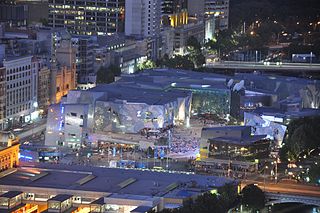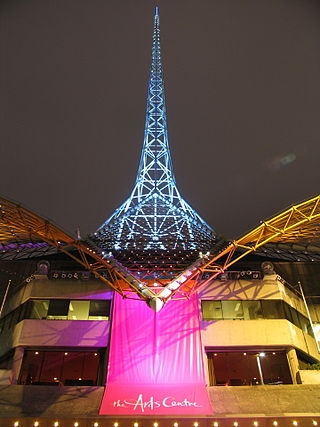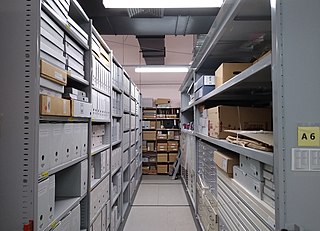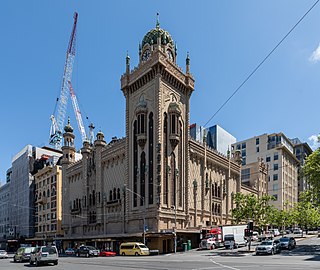Related Research Articles

The National Gallery of Victoria, popularly known as the NGV, is an art museum in Melbourne, Victoria, Australia. Founded in 1861, it is Australia's oldest and most visited art museum.

Federation Square is a venue for arts, culture and public events on the edge of the Melbourne central business district. It covers an area of 3.2 ha at the intersection of Flinders and Swanston Streets built above busy railway lines and across the road from Flinders Street station. It incorporates major cultural institutions such as the Ian Potter Centre, Australian Centre for the Moving Image (ACMI) and the Koorie Heritage Trust as well as cafes and bars in a series of buildings centred around a large paved square, and a glass walled atrium.

Arts Centre Melbourne, originally known as the Victorian Arts Centre and briefly called the Arts Centre, is a performing arts centre consisting of a complex of theatres and concert halls in the Melbourne Arts Precinct, located in the central Melbourne suburb of Southbank in Victoria, Australia.

Southbank is an inner-city suburb in Melbourne, Victoria, Australia, 1 km south of the Melbourne central business district, located within the Cities of Melbourne and Port Phillip local government areas. Southbank recorded a population of 22,631 at the 2021 census.

The Melbourne Convention and Exhibition Centre, colloquially referred to as "Jeff's Shed," is a group of three adjacent buildings next to the Yarra River in South Wharf, an inner-city suburb of Melbourne, Victoria, Australia. The venues are owned and operated by the Melbourne Convention and Exhibition Trust.
ACMI, formerly the Australian Centre for the Moving Image, is Australia's national museum of screen culture including film, television, videogames, digital culture and art. ACMI was established in 2002 and is based at Federation Square in Melbourne, Victoria.

Melbourne Recital Centre is a venue for live music in Melbourne and welcomes over 200,000 visitors each year. The organisation programs and presents more than 500 concerts and events a year across diverse range of musical genres including classical and chamber, contemporary, pop, folk, rock, electronica, indie, jazz, cabaret and world music. It was opened in 2009, as part of the Melbourne Recital Centre and Melbourne Theatre Company Southbank Theatre complex designed by Ashton Raggat McDougall, and is located on the corner of Southbank Boulevard and Sturt Street in the Melbourne Arts Precinct, Southbank. It is Melbourne's second largest auditorium for classical music.

Melbourne is the capital of the Australian state of Victoria, and the second-most populous city in Australia. Its name generally refers to a 9,993 km2 (3,858 sq mi) metropolitan area known as Greater Melbourne, comprising an urban agglomeration of 31 local municipalities, although the name is also used specifically for the local municipality of City of Melbourne based around its central business area. The metropolis occupies much of the northern and eastern coastlines of Port Phillip Bay and spreads into the Mornington Peninsula, part of West Gippsland, as well as the hinterlands towards the Yarra Valley, the Dandenong and Macedon Ranges. It has a population over 5 million, mostly residing to the east side of the city centre, and its inhabitants are commonly referred to as "Melburnians".

Hamer Hall is a 2,466 seat concert hall, the largest indoor venue at Arts Centre Melbourne, used for orchestra and contemporary music performances. It was designed by Roy Grounds as part of the Cultural Centre that comprised the National Gallery of Victoria and the Arts Centre Melbourne. It was opened as the 'Melbourne Concert Hall' in 1982 and was renamed Hamer Hall in honour of Rupert Hamer shortly after his death in 2004.

The Australian Performing Arts Collection at Arts Centre Melbourne, formerly known as Performing Arts Museum (PAM), is the largest specialist performing arts collection in Australia, with over 780,000 items relating to the history of circus, dance, music, opera and theatre in Australia and of Australian performers overseas.
Peter Sebastian Graham is a contemporary Australian artist, painter, printmaker and sculptor. He was born in 1970 in Sydney, New South Wales. He moved with his family in 1983 to Melbourne, Victoria, where he currently lives and works.

Julie Gough is an artist, writer and curator based in Tasmania, Australia.
Maree Clarke is a Mutti Mutti, Yorta Yorta, BoonWurrung/Wemba Wemba woman living in Melbourne, known for her work as a curator and artist. Clarke is a multidisciplinary artist renowned for her work in reviving South-eastern Aboriginal Australian art practices.
Narputta Nangala Jugadai (1933–2010) was an Aboriginal Australian artist born at Karrkurutinytja, who later lived at Haasts Bluff (Ikuntji) in the Northern Territory. Her language group was Pintupi/Pitjantjatjara, and her Dreaming was "Snake", "Jangala, Two Men" and "Two Women". She was a senior artist in her community at Ikuntji and prominent among the Ikuntji Women's Centre painters. She was the wife of the painter, Timmy Tjungurrayi Jugadai, and mother of Daisy Jugadai Napaltjarri and Molly Jugadai Napaltjarri.
Mel O'Callaghan is an Australian-born contemporary artist who works in video, performance, sculpture, installation, and painting. Her work has been exhibited in solo and group exhibitions around the world and received a number of awards for her artistic practice, and her work is held in a various collections in Australia and France.

Hoda Afshar is an Iranian documentary photographer who is based in Melbourne. She is known for her 2018 prize-winning portrait of Kurdish-Iranian refugee Behrouz Boochani, who suffered a long imprisonment in the Manus Island detention centre run by the Australian government. Her work has been featured in many exhibitions and is held in many permanent collections across Australia.
The Melbourne Arts Precinct Corporation is a Victorian Government corporation responsible for the $1.7 billion transformation of the Melbourne Arts Precinct.
Margaret Plant is a Professor of Australian art history, and as of November 2022 Emeritus Professor of Visual Arts at Monash University.
References
- ↑ Schout, David. "Arts Precinct works to start in June". southbanklocalnews.com.au. Southbank Local News. Retrieved 6 October 2022.
- ↑ Coster, Alice (8 September 2008). "$128m plans unveiled for Arts Precinct". Herald Sun .
- ↑ Melbourne's arts precinct receives nation's highest honour Archived 8 April 2011 at the Wayback Machine - Building Product News (BPN.com.au), 22 June 2009
- ↑ "Once-In-A-Generation Transformation Of Arts Precinct". premier.vic.gov.au. Victorian Government. Retrieved 3 October 2022.
- ↑ "A step forward for transformation of Melbourne's arts precinct". architectureau.com. Architecture AU. Retrieved 6 October 2022.
- ↑ "Backing Australia's Cultural Capital And The Jobs It Creates". premier.vic.gov.au. Victorian Government. Retrieved 3 October 2022.
- ↑ "Creating Jobs And Transforming Melbourne's Creative Heart". premier.vic.gov.au. Victorian Government. Retrieved 3 October 2022.
- ↑ Watts, Richard. "Extra $241M for arts precinct redevelopment". artshub.com.au. Arts Hub. Retrieved 3 October 2022.
- ↑ Arts and Culture brochure - City of Melbourne
- ↑ "Creative Leader To Spearhead Arts Precinct Transformation". premier.vic.gov.au. Victorian Government. Retrieved 3 October 2022.
- ↑ Dalgarno, Paul. "ACMI's Katrina Sedgwick set to lead new Melbourne Arts Precinct". Arts Hub. Retrieved 3 October 2022.
- ↑ "Foxes' $100 million NGV gift a generous vote of confidence in Melbourne". The Age . Retrieved 3 October 2022.
- ↑ "Striking Design Revealed For New Global Arts Destination". premier.vic.gov.au. Victorian Government. Retrieved 3 October 2022.
- ↑ "Winning design revealed for NGV Contemporary". Architecture AU. Retrieved 3 October 2022.